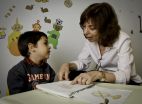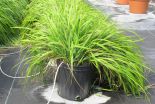On warmer Earth, most of Arctic may remove, not add, methane
2015-08-17
(Press-News.org) In addition to melting icecaps and imperiled wildlife, a significant concern among scientists is that higher Arctic temperatures brought about by climate change could result in the release of massive amounts of carbon locked in the region's frozen soil in the form of carbon dioxide and methane. Arctic permafrost is estimated to contain about a trillion tons of carbon, which would potentially accelerate global warming. Carbon emissions in the form of methane have been of particular concern because on a 100-year scale methane is about 25-times more potent than carbon dioxide at trapping heat.
However, new research led by Princeton University researchers and published in The ISME Journal in August suggests that, thanks to methane-hungry bacteria, the majority of Arctic soil might actually be able to absorb methane from the atmosphere rather than release it. Furthermore, that ability seems to become greater as temperatures rise.
The researchers found that Arctic soils containing low carbon content -- which make up 87 percent of the soil in permafrost regions globally -- not only remove methane from the atmosphere, but also become more efficient as temperatures increase. During a three-year period, a carbon-poor site on Axel Heiberg Island in Canada's Arctic region consistently took up more methane as the ground temperature rose from 0 to 18 degrees Celsius (32 to 64.4 degrees Fahrenheit). The researchers project that should Arctic temperatures rise by 5 to 15 degrees Celsius over the next 100 years, the methane-absorbing capacity of "carbon-poor" soil could increase by five to 30 times.
The researchers found that this ability stems from an as-yet unknown species of bacteria in carbon-poor Arctic soil that consume methane in the atmosphere. The bacteria are related to a bacterial group known as Upland Soil Cluster Alpha, the dominant methane-consuming bacteria in carbon-poor Arctic soil. The bacteria the researchers studied remove the carbon from methane to produce methanol, a simple alcohol the bacteria process immediately. The carbon is used for growth or respiration, meaning that it either remains in bacterial cells or is released as carbon dioxide.
First author Chui Yim "Maggie" Lau, an associate research scholar in Princeton's Department of Geosciences, said that although it's too early to claim that the entire Arctic will be a massive methane "sink" in a warmer world, the study's results do suggest that the Arctic could help mitigate the warming effect that would be caused by a rising amount of methane in the atmosphere. In immediate terms, climate models that project conditions on a warmer Earth could use this study to more accurately calculate the future methane content of the atmosphere, Lau said.
"At our study sites, we are more confident that these soils will continue to be a sink under future warming. In the future, the Arctic may not have atmospheric methane increase as much as the rest of the world," Lau said. "We don't have a direct answer as to whether these Arctic soils will offset global atmospheric methane or not, but they will certainly help the situation."
The researchers want to study the bacteria's physiology as well as test the upper temperature threshold and methane concentrations at which they can still efficiently process methane, Lau said. Field observations showed that the bacteria are still effective up to 18 degrees Celsius (64.4 degrees Fahrenheit) and can remove methane down to one-quarter of the methane level in the atmosphere, which is around 0.5 parts-per-million.
"If these bacteria can still work in a future warmer climate and are widespread in other Arctic permafrost areas, maybe they could regulate methane for the whole globe," Lau said. "These regions may seem isolated from the world, but they may have been doing things to help the world."
INFORMATION:
From Princeton, Lau worked with geoscience graduate student and second author Brandon Stackhouse; Nicholas Burton, who received his bachelor's degree in geosciences in 2013; David Medvigy, an assistant professor of geosciences; and senior author Tullis Onstott, a professor of geosciences. Co-authors on the paper were from the University of Tennessee-Knoxville; the Oak Ridge National Laboratory; McGill University; Laurentian University in Canada; and the University of Texas at Austin.
The research was supported by the U.S. Department of Energy, Office of Science, Office of Biological and Environmental Research (DE-SC0004902); the National Science Foundation (grant no. ARC-0909482); the Canada Foundation for Innovation (grant no. 206704); the Natural Sciences and Engineering Research Council of Canada Discovery Grant Program (grant no. 298520-05); and the Northern Research Supplements Program (grant no. 305490-05)
M.C.Y. Lau, B.T. Stackhouse, A.C. Layton, A. Chauhan, T. A. Vishnivetskaya, K. Chourey, J. Ronholm, N.C.S. Mykytczuk, P.C. Bennett, G. Lamarche-Gagnon, N. Burton, W.H. Pollard, C.R. Omelon, D.M. Medvigy, R.L. Hettich, S.M. Pfiffner, L.G. Whyte, and T.C. Onstott. 2015. An active atmospheric methane sink in high Arctic mineral cryosols. The ISME Journal. Article published in print August 2015. DOI:10.1038/ismej.2015.13.
ELSE PRESS RELEASES FROM THIS DATE:
2015-08-17
Magnetism in nanoscale layers only a few tens of atoms thick is one of the foundations of the big data revolution - for example, all the information we download from the internet is stored magnetically on hard disks in server farms dotted across the World. Recent work by a team of scientists working in Singapore, The Netherlands, USA and Ireland, published on 14 August 2015 in the prestigious journal, Science, has uncovered a new twist to the story of thin-film magnetism.
The team from the National University of Singapore (NUS) - Mr Li Changjian, a graduate student from ...
2015-08-17
Bilingual children pose unique challenges for clinicians, and, until recently, there was little research on young bilinguals to guide clinical practice. In the past decade, however, research on bilingual development has burgeoned, and the scientific literature now supports several conclusions that should help clinicians as they assess bilingual children and advise their parents.
In an article recently published in Seminars in Speech and Language, Erika Hoff, Ph.D., a professor of psychology in the Charles E. Schmidt College of Science at Florida Atlantic University, ...
2015-08-17
ANN ARBOR, Mich. - One of the most common complaints about hospitals is the noise. Patients complain that they can't sleep soundly in the environment of multiple monitors, paging systems, wheelchairs and gurneys, and carts that squeak.
Ongoing efforts at the University of Michigan Health System are making the hospital quieter, and the hospital has tested sound panels designed to dial down noise.
During a pilot study, strategically placed sound acoustic panels helped diffuse sound in the hallways around patient rooms. The modest 3-4 sound decibel drop is recognizable ...
2015-08-17
When researchers dream about electronics of the future, they more or less dream of pouring liquids into a beaker, stirring them together and decanting a computer out onto the table. This field of research is known as self-assembling molecular electronics. But, getting chemical substances to self-assemble into electronic components is just as complicated as it sounds. Now, a group of researchers has published their breakthrough within the field. The group consists of first-year nanoscience students from the University of Copenhagen.
Thomas Just Sørensen, an associate ...
2015-08-17
This news release is available in German. Two growth-promoting groups of substances, or phytohormones, the gibberellins and the brassinosteroids, are used independently of each other for the breeding and production of crop plants. A team of scientists at Technical University of Munich (TUM) has now discovered that the two act in concert - without brassinosteroids, a plant is unable to produce gibberellins.
For their current investigations, a research group at the Technical University of Munich, supported by scientists from the Helmholtz Zentrum Munich and the TU Braunschweig ...
2015-08-17
ANN ARBOR, Mich. -- With every breath you take, microbes have a chance of making it into your lungs. But what happens when they get there? And why do dangerous lung infections like pneumonia happen in some people, but not others?
Researchers at the University of Michigan Medical School have started to answer these questions by studying the microbiome of the lungs - the community of microscopic organisms are in constant contact with our respiratory system.
By studying these bacterial communities, and how they change in illness, they hope to pave the way for new ways ...
2015-08-17
Troubling questions about multiracial congregations' potential to address racial inequality are raised by a new national study done by researchers at Baylor University, the University of Southern California and the University of Chicago.
The study -- "United by Faith? Race/Ethnicity, Congregational Diversity, and Explanations of Racial Inequality" -- is published in the journal Sociology of Religion.
"We find little evidence that multiracial congregations promote progressive racial views among attendees of any race or ethnicity," the researchers wrote. Views of minorities ...
2015-08-17
BOSTON, Aug. 17, 2015 --Native North Americans have long adorned themselves and their homes with fragrant sweetgrass (Hierochloe odorata), a native plant used in traditional medicine, to repel biting insects, and mosquitoes in particular. Now, researchers report that they have identified the compounds in sweetgrass that keep these bugs at bay.
The team will describe their approach in one of more than 9,000 presentations at the 250th National Meeting & Exposition of the American Chemical Society (ACS), the world's largest scientific society, taking place here through Thursday.
Mosquitoes ...
2015-08-17
BOSTON, Aug. 17, 2015 -- Hand-written letters and printed photos seem quaint in today's digital age. But there's one thing that traditional media have over hard drives: longevity. To address this modern shortcoming, scientists are turning to DNA to save unprecedented amounts of digital data for posterity. One team has demonstrated that DNA they encapsulated can preserve information for at least 2,000 years, and they're now working on a filing system to make it easier to navigate.
The researchers present their work today at the 250th National Meeting & Exposition of the ...
2015-08-17
BOSTON, Aug. 17, 2015 -- A blood clot is a dangerous health situation with the potential to trigger heart attacks, strokes and other medical emergencies. To treat a blood clot, doctors need to find its exact location. But current clinical techniques can only look at one part of the body at a time, slowing treatment and increasing the risk for complications. Now, researchers are reporting a method, tested in rats, that may someday allow health care providers to quickly scan the entire body for a blood clot.
The team will describe their approach in one of more than 9,000 ...
LAST 30 PRESS RELEASES:
[Press-News.org] On warmer Earth, most of Arctic may remove, not add, methane




